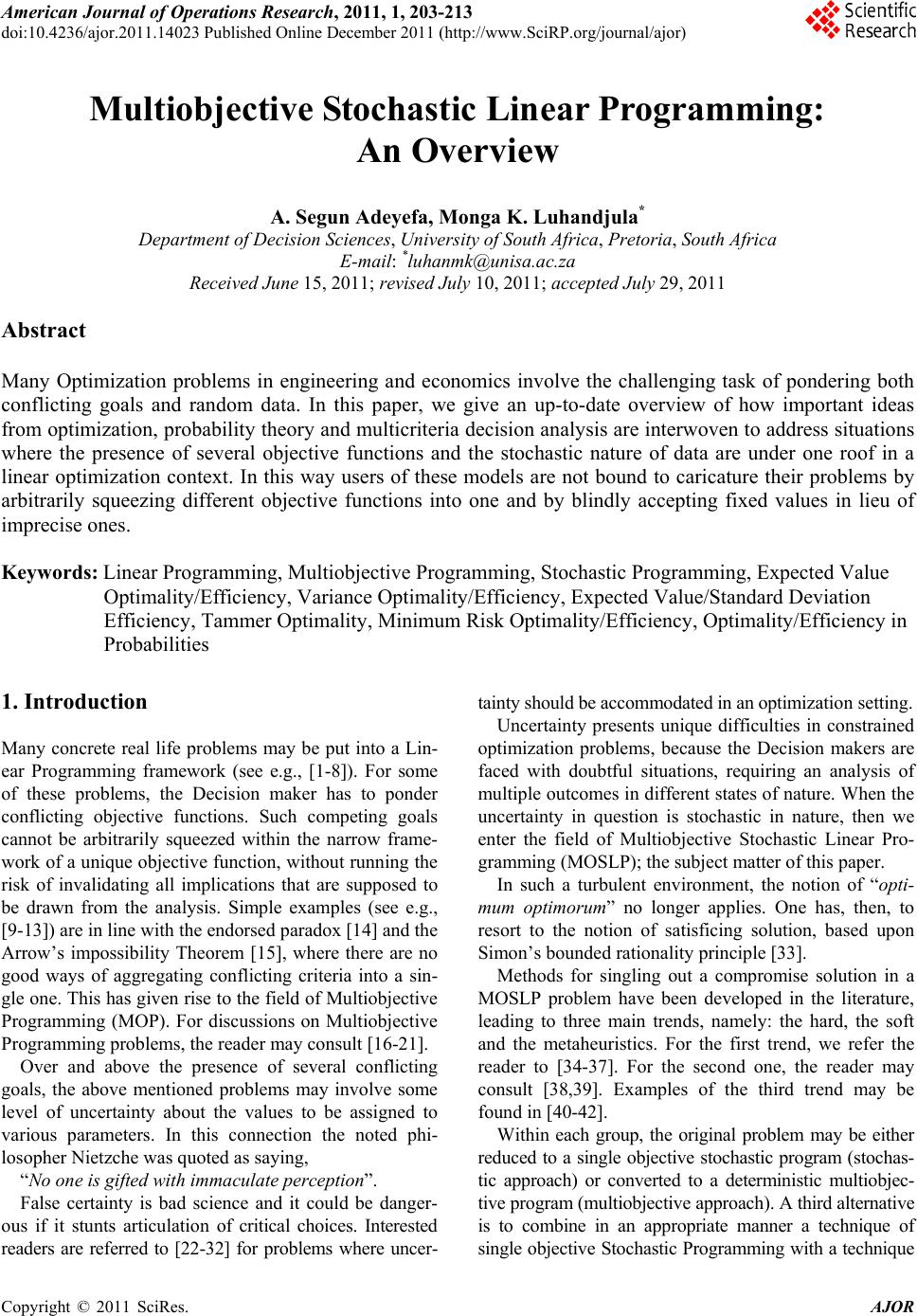 American Journal of Oper ations Research, 2011, 1, 203-213 doi:10.4236/ajor.2011.14023 Published Online December 2011 (http://www.SciRP.org/journal/ajor) Copyright © 2011 SciRes. AJOR 203 Multiobjective Stochastic Linear Programming: An Overview A. Segun Adeyefa, Monga K. Luhandjula* Department of Deci sio n Sci e n ces , Uni versi t y of So ut h Africa, Pretoria, South Africa E-mail: *luhanmk@unisa.ac.za Received June 15, 2011; revised July 10, 2011; accept ed July 29, 2011 Abstract Many Optimization problems in engineering and economics involve the challenging task of pondering both conflicting goals and random data. In this paper, we give an up-to-date overview of how important ideas from optimization, probability theory and multicriteria decision analysis are interwoven to address situations where the presence of several objective functions and the stochastic nature of data are under one roof in a linear optimization context. In this way users of these models are not bound to caricature their problems by arbitrarily squeezing different objective functions into one and by blindly accepting fixed values in lieu of imprecise ones. Keywords: Linear Programming, Multiobjective Programming, Stochastic Programming, Expected Value Optimality/Efficiency, Variance Optimality/Efficiency, Expected Value/Standard Deviation Efficiency, Tammer Optimality, Minimum Risk Optimality/Efficiency, Optimality/Efficiency in Probabilities 1. Introduction Many concrete real life problems may be put into a Lin- ear Programming framework (see e.g., [1-8]). For some of these problems, the Decision maker has to ponder conflicting objective functions. Such competing goals cannot be arbitrarily squeezed within the narrow frame- work of a unique objective function, without running the risk of invalidating all implications that are supposed to be drawn from the analysis. Simple examples (see e.g., [9-13]) are in line with the endorsed paradox [14] and the Arrow’s impossibility Theorem [15], where there are no good ways of aggregating conflicting criteria into a sin- gle one. This has given rise to the field of Multiobjective Programming (MOP). For discussions on Multiobjective Programming problems, the reader may consult [16-21]. Over and above the presence of several conflicting goals, the above mentioned problems may involve some level of uncertainty about the values to be assigned to various parameters. In this connection the noted phi- losopher Nietzche was quoted as saying, “No one is gifted with immaculate perception”. False certainty is bad science and it could be danger- ous if it stunts articulation of critical choices. Interested readers are referred to [22-32] for problems where uncer- tainty should be accommodated in an optimization setting. Uncertainty presents unique difficulties in constrained optimization problems, because the Decision makers are faced with doubtful situations, requiring an analysis of multiple outcomes in different states of nature. When the uncertainty in question is stochastic in nature, then we enter the field of Multiobjective Stochastic Linear Pro- gramming (MOSLP); the subject matter of this paper. In such a turbulent environment, the notion of “opti- mum optimorum” no longer applies. One has, then, to resort to the notion of satisficing solution, based upon Simon’s bounded rationality principle [33]. Methods for singling out a compromise solution in a MOSLP problem have been developed in the literature, leading to three main trends, namely: the hard, the soft and the metaheuristics. For the first trend, we refer the reader to [34-37]. For the second one, the reader may consult [38,39]. Examples of the third trend may be found in [40-42]. Within each group, the original problem may be either reduced to a single objective stochastic program (stochas- tic approach) or converted to a deterministic multiobjec- tive program (multiobjective approach). A third alternative is to combine in an appropriate manner a technique of single objective Stochastic Programming with a technique 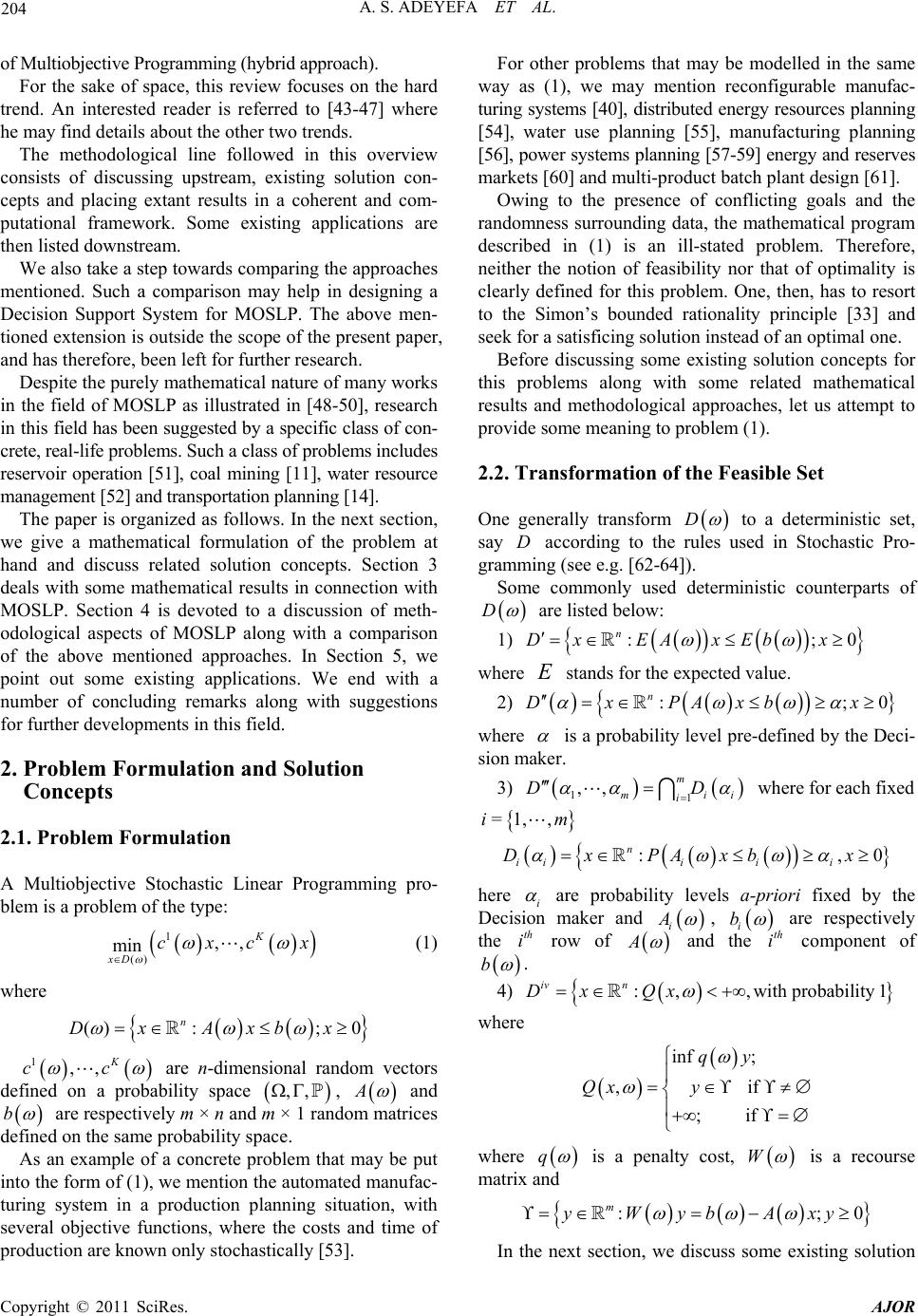 A. S. ADEYEFA ET AL. 204 of Multiobjective Programming (hybrid approach). For the sake of space, this review focuses on the hard trend. An interested reader is referred to [43-47] where he may find details about the other two trends. The methodological line followed in this overview consists of discussing upstream, existing solution con- cepts and placing extant results in a coherent and com- putational framework. Some existing applications are then listed downstream. We also take a step towards comparing the approaches mentioned. Such a comparison may help in designing a Decision Support System for MOSLP. The above men- tioned extension is outside the scope of the present paper, and has therefore, been left for further research. Despite the purely mathematical nature of many works in the field of MOSLP as illustrated in [48-50], research in this field has been suggested by a specific class of con- crete, real-life problems. Such a class of problems includes reservoir operation [51], coal mining [11], water resource management [52] and transportation planning [14]. The paper is organized as follows. In the next section, we give a mathematical formulation of the problem at hand and discuss related solution concepts. Section 3 deals with some mathematical results in connection with MOSLP. Section 4 is devoted to a discussion of meth- odological aspects of MOSLP along with a comparison of the above mentioned approaches. In Section 5, we point out some existing applications. We end with a number of concluding remarks along with suggestions for further developments in this field. 2. Problem Formulation and Solution Concepts 2.1. Problem Formulation A Multiobjective Stochastic Linear Programming pro- blem is a problem of the type: 1 () ,, min K xD cxc x (1) where ():; 0 n DxAxbx 1,, K cc are n-dimensional random vectors defined on a probability space , ,, A and b are respectively m × n and m × 1 random matrices defined on the same probability space. As an example of a concrete problem that may be put into the form of (1), we mention the automated manufac- turing system in a production planning situation, with several objective functions, where the costs and time of production are known only stochastically [53]. For other problems that may be modelled in the same way as (1), we may mention reconfigurable manufac- turing systems [40], distributed energy resources planning [54], water use planning [55], manufacturing planning [56], power systems planning [57-59] energy and reserves markets [60] and multi-product batch plant design [61]. Owing to the presence of conflicting goals and the randomness surrounding data, the mathematical program described in (1) is an ill-stated problem. Therefore, neither the notion of feasibility nor that of optimality is clearly defined for this problem. One, then, has to resort to the Simon’s bounded rationality principle [33] and seek for a satisficing solution instead of an optimal one. Before discussing some existing solution concepts for this problems along with some related mathematical results and methodological approaches, let us attempt to provide some meaning to problem (1). 2.2. Transformation of the Feasible Set One generally transform D to a deterministic set, say according to the rules used in Stochastic Pro- gramming (see e.g. [62-64]). D Some commonly used deterministic counterparts of D are listed below: 1) :; n DxEA xEbx 0 where stands for the expected value. 2) :; n DxPAxb x 0 where is a probability level pre-defined by the Deci- sion maker. 3) 11 ,, m mi i D i D where for each fixed =1, ,im :, n iiii i DxPAxb x 0 here i are probability levels a-priori fixed by the Decision maker and i A , i b are respectively the row of th i A and the component of th i b . 4) probability 1Dx: n,Qx , with iv where inf ; , if ; if qy Qx y where q is a penalty cost, W is a recourse matrix and :; m yWybAxy 0 In the next section, we discuss some existing solution Copyright © 2011 SciRes. AJOR 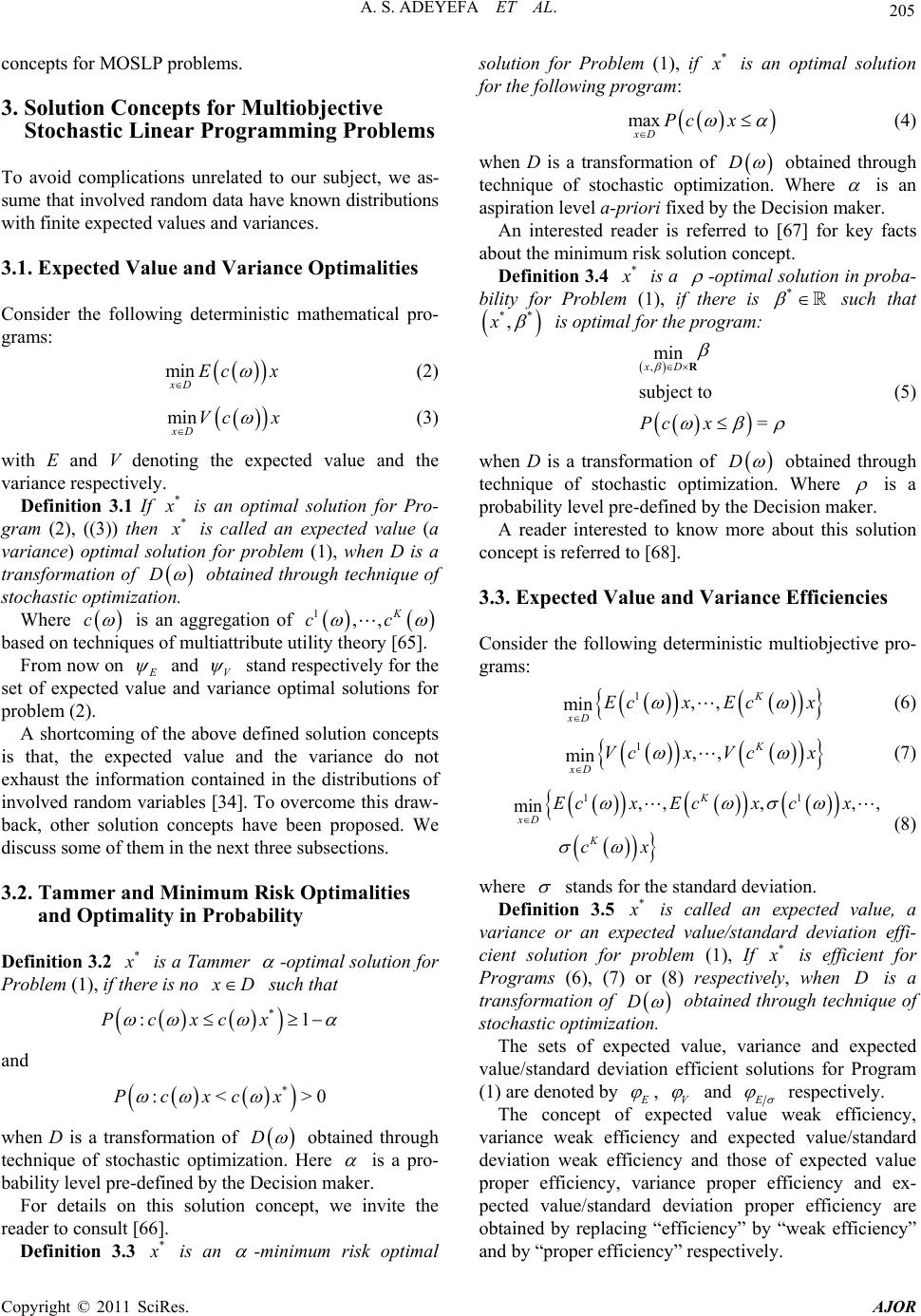 205 A. S. ADEYEFA ET AL. concepts for MOSLP problems. 3. Solution Concepts for Multiobjective Stochastic Linear Programming Problems To avoid complications unrelated to our subject, we as- sume that involved random data have known distributions with finite expected values and variances. 3.1. Expected Value and Variance Optimalities Consider the following deterministic mathematical pro- grams: min xDEc x (2) min xD Vc x (3) with E and V denoting the expected value and the variance respectively. Definition 3.1 If * is an optimal solution for Pro- gram (2), ((3)) then * is called an expected value (a variance) optimal solution for problem (1), when D is a transformation of D obtained through technique of stochastic optimization. Where c is an aggregation of 1,, K cc based on techniques of multiattribute utility theory [65]. From now on and V stand respectively for the set of expected value and variance optimal solutions for problem (2). A shortcoming of the above defined solution concepts is that, the expected value and the variance do not exhaust the information contained in the distributions of involved random variables [34]. To overcome this draw- back, other solution concepts have been proposed. We discuss some of them in the next three subsections. 3.2. Tammer and Minimum Risk Optimalities and Optimality in Probability Definition 3.2 * is a Tammer -optimal solution for Problem (1), if there is no D such that * :1Pcxcx and * :<Pcxcx >0 when D is a transformation of D obtained through technique of stochastic optimization. Here is a pro- bability level pre-defined by the Decision maker. For details on this solution concept, we invite the reader to consult [66]. Definition 3.3 * is an -minimum risk optimal solution for Problem (1), if * is an optimal solution for the following program: max xDPc x (4) when D is a transformation of D obtained through technique of stochastic optimization. Where is an aspiration level a-priori fixed by the Decision maker. An interested reader is referred to [67] for key facts about the minimum risk solution concept. Definition 3.4 * is a -optimal solution in proba- bility for Problem (1), if there is such that * ** ,x is optimal for the program: ,min subject to = xD Pc x R D (5) when D is a transformation of obtained through technique of stochastic optimization. Where is a probability level pre-defined by the Decision maker. A reader interested to know more about this solution concept is referred to [68]. 3.3. Expected Value and Variance Efficiencies Consider the following deterministic multiobjective pro- grams: 1 minK xD Ec xcx ,,E (6) 1 minK xD Vc xcx ,,V (7) 11 ,,, ,, min xD K Ec xEcxc x cx K (8) where stands for the standard deviation. Definition 3.5 * is called an expected value, a variance or an expected value/standard deviation effi- cient solution for problem (1), If * is efficient for Programs (6), (7) or (8) respectively, when is a transformation of D D obtained through technique of stochastic optimization. The sets of expected value, variance and expected value/standard deviation efficient solutions for Program (1) are denoted by , V and E respectively. The concept of expected value weak efficiency, variance weak efficiency and expected value/standard deviation weak efficiency and those of expected value proper efficiency, variance proper efficiency and ex- pected value/standard deviation proper efficiency are obtained by replacing “efficiency” by “weak efficiency” and by “proper efficiency” respectively. Copyright © 2011 SciRes. AJOR 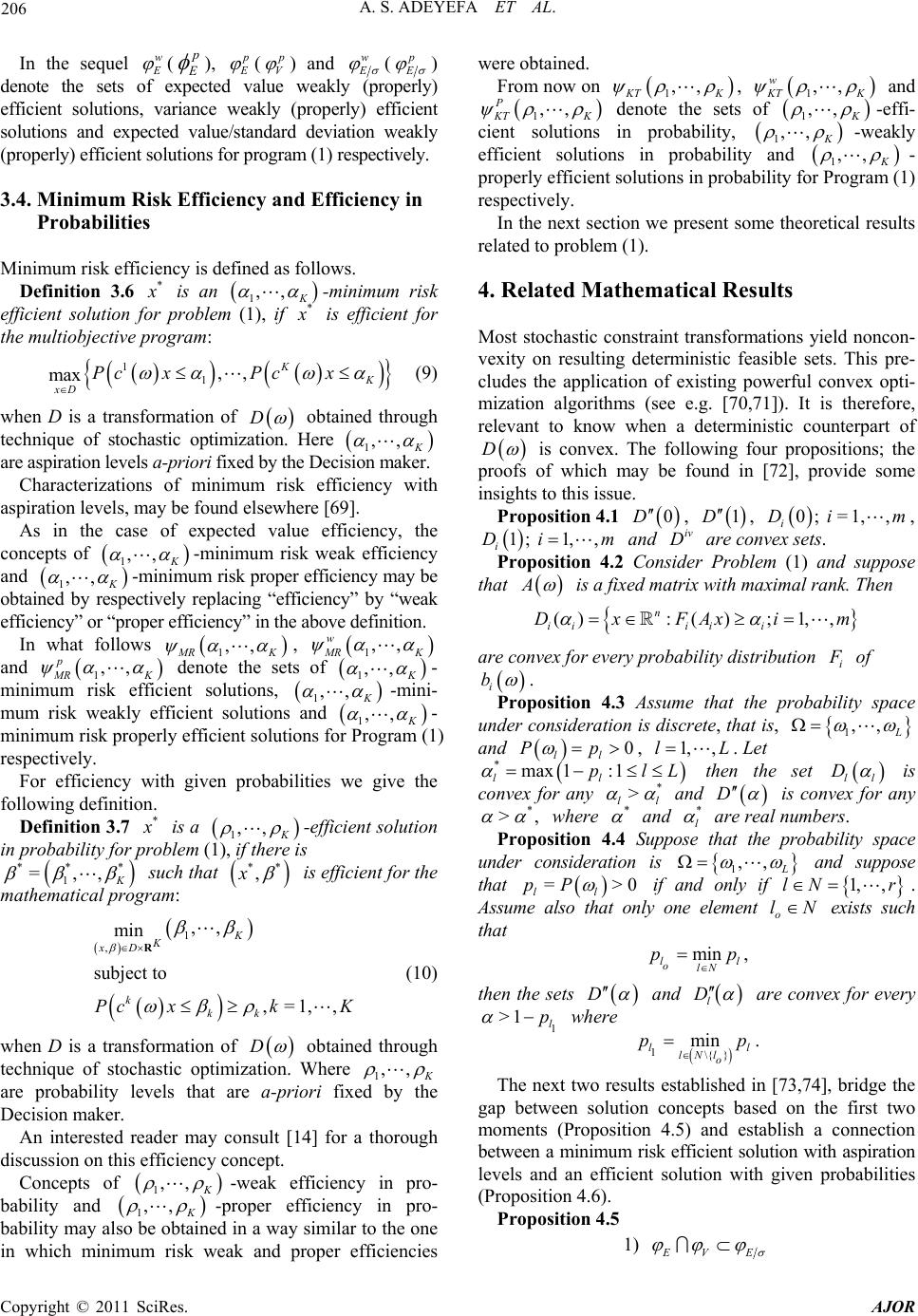 A. S. ADEYEFA ET AL. 206 In the sequel w (), p E ( V ) and w E ( E ) denote the sets of expected value weakly (properly) efficient solutions, variance weakly (properly) efficient solutions and expected value/standard deviation weakly (properly) efficient solutions for program (1) respectively. 3.4. Minimum Risk Efficiency and Efficiency in Probabilities Minimum risk efficiency is defined as follows. Definition 3.6 * is an 1,, *-minimum risk efficient solution for problem (1), if is efficient for the multiobjective program: 1 1,, max KK xD Pc xPcx (9) when D is a transformation of D obtained through technique of stochastic optimization. Here 1,, are aspiration levels a-priori fixed by the Decision maker. Characterizations of minimum risk efficiency with aspiration levels, may be found elsewhere [69]. As in the case of expected value efficiency, the concepts of 1,, -minimum risk weak efficiency and 1 ,, -minimum risk proper efficiency may be obtained by respectively replacing “efficiency” by “weak efficiency” or “proper efficiency” in the above definition. In what follows 1,, RK , 1,, w RK and 1 ,, p RK denote the sets of 1,, ,, - minimum risk efficient solutions, 1 1,, -mini- mum risk weakly efficient solutions and - minimum risk properly efficient solutions for Program (1) respectively. For efficiency with given probabilities we give the following definition. Definition 3.7 * is a 1,, -efficient solution in probability for problem (1), if there is 1 ** =,, * such that ** ,x is efficient for the mathematical program: 1 , ,, min subject to ,=1, , K K xD kkk Pc xkK R (10) when D is a transformation of D obtained through technique of stochastic optimization. Where 1,, are probability levels that are a-priori fixed by the Decision maker. An interested reader may consult [14] for a thorough discussion on this efficiency concept. Concepts of 1,, ,, -weak efficiency in pro- bability and 1 -proper efficiency in pro- bability may also be obtained in a way similar to the one in which minimum risk weak and proper efficiencies were obtained. From now on 1,, TK , 1,, w TK and 1,, P TK denote the sets of 1,, 1,, -effi- cient solutions in probability, 1,, -weakly efficient solutions in probability and - properly efficient solutions in probability for Program (1) respectively. In the next section we present some theoretical results related to problem (1). 4. Related Mathematical Results Most stochastic constraint transformations yield noncon- vexity on resulting deterministic feasible sets. This pre- cludes the application of existing powerful convex opti- mization algorithms (see e.g. [70,71]). It is therefore, relevant to know when a deterministic counterpart of D is convex. The following four propositions; the proofs of which may be found in [72], provide some insights to this issue. Proposition 4.1 0D , 1D , , 0; =1,, i Dim 1;1, , i Dimiv D and are convex sets. Proposition 4.2 Consider Problem (1) and suppose that A is a fixed matrix with maximal rank. Then ():(); 1,, n iiii i DxFAxi m are convex for every probability distribution i of i b . Proposition 4.3 Assume that the probability space under consideration is discrete, that is, 1,, and 0 ll Pp , 1, ,lL . Let l L * max 1:1 l pl then the set ll D is convex for any l * > l D and is convex for any * >, * where and * l are real numbers. Proposition 4.4 Suppose that the probability space under consideration is 1,, and suppose that => ll pP 0 if and only if 1, ,lN r N. Assume also that only one element exists such that o l min ll olN pp , then the sets D and l D are convex for every 1 >1 l p where 1\{ } ll lN l o minpp . The next two results established in [73,74], bridge the gap between solution concepts based on the first two moments (Proposition 4.5) and establish a connection between a minimum risk efficient solution with aspiration levels and an efficient solution with given probabilities (Proposition 4.6). Proposition 4.5 1) EV E Copyright © 2011 SciRes. AJOR 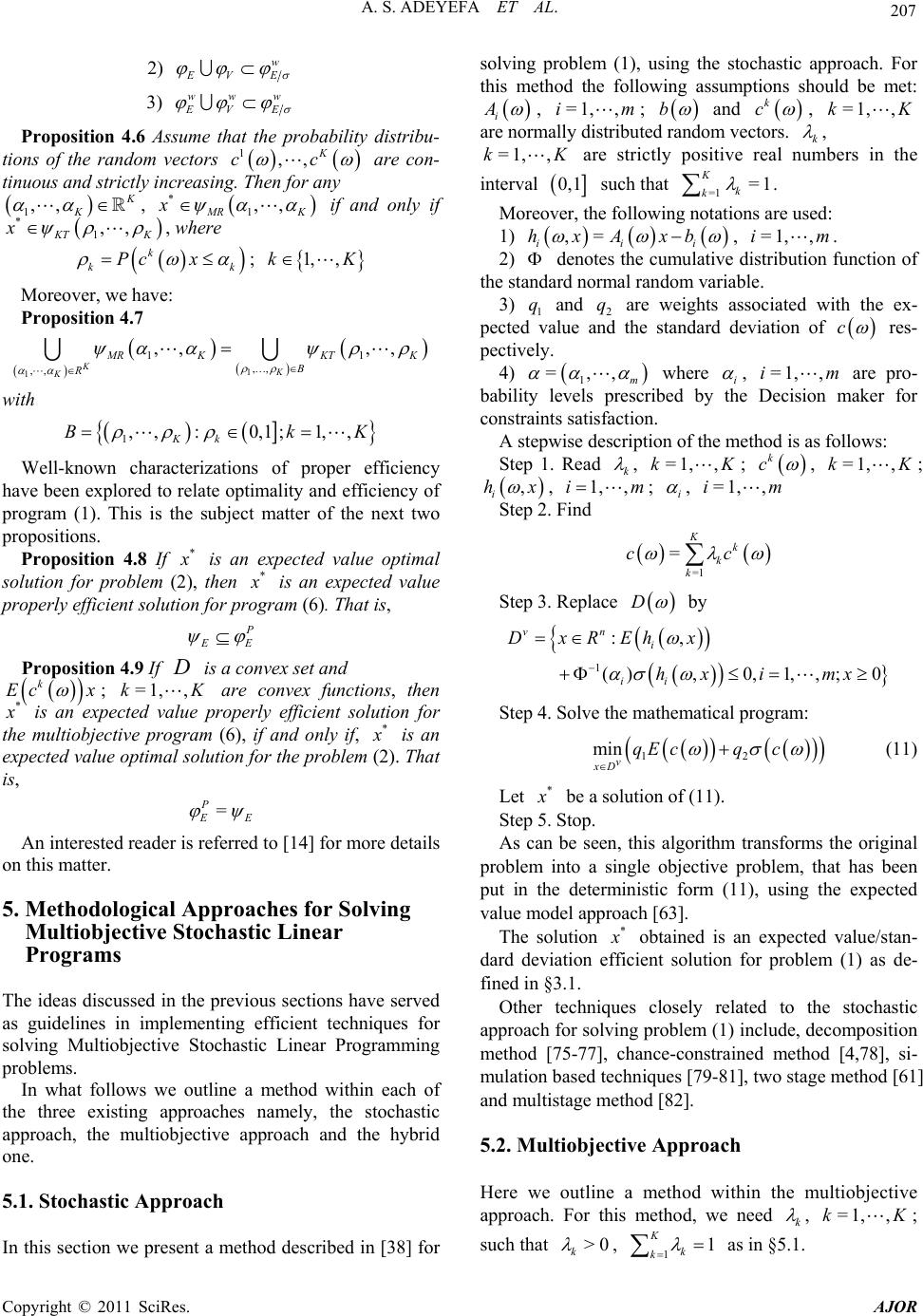 207 A. S. ADEYEFA ET AL. 2) w EV E 3) ww w EV E AsProposition 4.6sume that the probability distribu- tions of the random vectors 1,, K cc are con- tinuous and strictly increasing 1,, . Then for any K , * 1,, RK x if a only if nd * 1,, TK x , where k kk Pc x ; 1, ,kK Moreover, we have: 1 Proposition 4.7 1 , 1 1,, ,, , ,, KK K RK KT B R K with 1,,:0,1; 1,, Kk B kK Well-known characterizations of proper efficiency have been explored to relate optimality and efficiency of program (1). This is the subject matter of the next two propositions. Proposition 4.8 If * is an expected value optimal solution for problem (2 then * ), is an expected value properly efficient solution for program (6). That is, E Proposition 4.9 If is a convex set and ions, then D , k c x ; =1,kK are convex functE * is an the expected v palueroperly efficient solution for multiobjective program (6), if and only if, * is an expected value optimal solution for the problem ). That is, (2 = P E An interested reader is referred to [14] for more details on ogical Approaches for Solving hed in the previous sections have served tochastic Approach ethod described in [38] for olving problem (1), using the stochastic approach. For this matter. . Methodol5Multiobjective Stochastic Linear Programs e ideas discussT as guidelines in implementing efficient techniques for solving Multiobjective Stochastic Linear Programming problems. In what follows we outline a method within each of the three existing approaches namely, the stochastic approach, the multiobjective approach and the hybrid one. .1. S5 In this section we present a m s this method the following assumptions should be met: i A , =1,,im; b and k c , =1, ,kK are normally distributed random vectors. k , , interval =1,kK are strictly positive real numbers in the 0,1 such that =1 K . =1 k k the follo notations are used: Moreovewing 1) r, =hxAx ,b iii 1,, =,im. 2) denotes the cumulative distribution function of the standard normal random variable. ion of 3) 1 and 2 q are weights associated with the ex- pected value and the standard deviat q c res- pectiv. 4) ely 1 =,, m where i , =1, ,im pro- bability le on m are bed by the Decisiaker for constraints satisfaction vels prescri . A stepwise description of the method is as follows: Step 1. Read k , =k1, ,; K k c , =1, ,kK; ,x , 1, ,im i h ; i , =1,,im Step 2. Find K =1 =k k k cc D by Step 3. Replace 1 (),0,1,,;0 vn i ii h hx imx :,DxRE x Step 4. Solve the mathematical program: 12 min v xD qEcqc (11) Let * Step 5. Stop. be a solution of (11). an transforms the original prngle objective problem, that has been pu As cbe seen, this algorithm oblem into a si t in the deterministic form (11), using the expected value model approach [63]. The solution * obtained is an expected value/stan- dard deviation efficient solution for problem (1) as de- fin olving problem (1) include, decomposition m ach n the multiobjective proach. For this method, we need ed in §3.1. Other techniques closely related to the stochastic approach for s ethod [75-77], chance-constrained method [4,78], si- mulation based techniques [79-81], two stage method [61] and multistage method [82]. 5.2. Multiobjective Appro Here we outline a method withi ap k , =1, ,kK; such that >0 k , 11 K k k as in §5.1. Copyright © 2011 SciRes. AJOR  A. S. ADEYEFA ET AL. 208 : Read The steps of the method are as follow Step 1. k , =1, ,kK; k c , A=1, ,kK; ; b . Step 2. Replace D by :0DxEA xEbx n R ;0 (12) Step 3. Find: 1,, K Ec Ec Step 4. Solve the mathematical program: (13) Let min Kk Ecx =1 k xD k * Step 5. Stop. be a solution of (13) is mtackle randomness, while St objective functions. The so In thethod, Steps 2 and 3 ep 4 als with multiplicity of de lution * obtained is an expected value efficient solu- tion for MOSLP problem (1) as defined in §3.3. For a more thorough discussion of other methods for solving MOSLP problem (1) based on the multiobjective approach, the reader is referred to [83-89]. 5.3. Hybrid Approach In this section, we describe for solving MOSLP proble a hybrid method due to [90], m (1). This method is based on the assumptions given in §5.1. The following nota- tions are used in the sequel. 1) , =1,, S; t , =1, ,tT; u , u , =1, ,uU denote positive,and two sided deviations from targets negative , =1,, S; t , =1, u ,tT; , =1, ,uU respectively. S, T and U are respectively the total number of positive, negative and two-sided deviationsm targets fro , t anu d . 2) , =1,, S; t , =1, ,tT; u , =1, ,uU are probability levels a-priori fixed by the Decision maker. Herhe steps of the method. Step 1. Read S, T, U, e are t , , =1,, S; t , t , =1, ,tT; u , u , =1, ,uU; k c , =1, ,K; k ,hx , =1,,im i Step 2. Put D the following form in: 1 1 1 : )0 s cx g ( , 1,,; 1()0, 1,,; 1 0 2 vi s sss t t ttt u k uu Dx Ex sSEcx cxg tTEcx cxg nc 1 1,,;, ,0 1,,;0,0, 0 i ii st uUEhx hx im x Step 3. Solve the mathematical program: 1 T 11 min vi US uus t xD ust (14) Let * Step 4. Stop. be a solution of (14). It is clear that this method combines the goal program- ming technique for solving a multiobjective program with the chance-constrained method for soing a sto- chastic optimization problem. Other methods pertaining to the hybrid approach may be 5.4. Comparison of Different Approach Thinn while comparing the abed above are as follow: nt than requires lv found in [91-93]. es e ma lessons that can be draw pproaches outlinove described a 1) The stochastic approach takes into account depen- dencies between objective functions, whereas the multi- objective approach does not (see for example [94]). This makes the stochastic approach closer to reality. Therefore, the stochastic approach is more effective for finding solutions to a MOSLP problem than the multiobjective pproach. a 2) The multiobjective approach is more efficie he stochastic approach, in the sense that it t fewer computations. These computations are easier to handle than those required by the stochastic approach. (see e.g., [49,58,95]). 3) The hybrid approach combines the strengths of the stochastic and the multiobjective approaches. Conse- quently, the hybrid approach could perform better than either of the other two approaches for a given problem. Interested readers may consult [96] for a substantiation of this claim. 4) Methods pertaining to the hybrid approach create more flexibility in allowing the Decision maker to specify his preferences (see e.g., [91]). Nevertheless, it is the nature and the structure of the problem that determines which approach to use. In what follows, we briefly discuss some applications of Multiobjective Stochastic Linear Programming to concrete real-life problems. 6. Applications 6.1. Applications of the Stochastic Approach Production planning problems, lend themselves better to Copyright © 2011 SciRes. AJOR  A. S. ADEYEFA ET AL. 209 matter of fact, th ns and la wer system security problem preventive maintenance scheduling ing [99], hydro-thermal electricity res- ant esign [61]. problems [86], ar rtation network design problem [85] and . 6.3.s within the Hybrid Approach s, it is be ch, to e thods described in this field are valuable re caricature the underlying problem by itional (deterministic) Paraphrasing Howard [110], the scientific approach to es, along with the meaning of in of MOSLP. To cater best for a br logical aspects and applications) ha ration Research techniques ignore managerial ne been us nagement needs have evolved and are more co uided an cy ob velopments in this field we m to ltiobjective Fuzzy Linear Pro- gr der uncertainty. the use of the stochastic approach. As a e structure of these problems dictates that one starts dealing with the multiplicity of objective functio ter tackles the randomness in data [97]. Some other applications of the stochastic approach to MOSLP problems include po [98], power plant [75], capacity plann generation [100], deployment of roadway incident ponse vehicles [101] and multi-product batch pl d 6.2. Applications along the Multiobjective Approach Water resource planning and management e most appropriately dealt with using the multiobjective approach. Random parameters are first transformed into appropriate fixed data, before the conflicting goals are sorted out. The literature is rich in models using the multiobjective approach. We list a few of them: Water use planning [55], workforce scheduling model [102], transpo nuclear generation of electricity problem [57,103] Application To significantly bridge the dangerous gap between the problems of designing reliable portfolio assets and the mathematical programming models used to solve them, the Decision maker should be able to consider different objective functions and incorporate imprecision into the model. Owing to the complexity of such problem st to couple different techniques in an appropriate way to solve them. There are several good papers using this approa which the reader may refer. The papers [96,104-109] ar some of them. 7. Concluding Remarks Multiobjective Stochastic Linear Programming is a worthwhile topic. It provides a glimpse into what it means to jostle with the complicated issue (which is nevertheless useful for applications) of combining ran- domness and multiplicity of objectives into an optimiza- tion setting. Me sources for those facing optimization problems in- volving conflicting goals and random parameters and wishing not to blindly replacing it with a trad optimization problem. decision making and problem solving has demonstrated that, it can provide efficient tools to those few who have the resources and the will to use it. The new challenge is to provide this help at an affordable price to all who could benefit from it. There is a rich array of methods that can be used to deal with both Multiobjective Programming and Stochas- tic Programming problems. This paper has somewhat demonstrated that, the Howards view applies to Multi- objective Stochastic Programing. Nevertheless, theoretical and computational issu troduced solution concepts, play a crucial role in such a turbulent environment. In this paper we have presented the main principle of MOSLP. We have also indicated that there are concrete realizations in this field. We have also discussed oppor- tunities and limitations oad readership, the paper has the following distinctive features: 1) It is organized towards the technique-oriented for- mat in contrast to the theoretically speculative one. 2) Practical aims take precedence over mathematical niceties. 3) The basic ideas (solution concepts, related mathe- matical results, methodo ve been presented in an understandable manner. 4) The paper is filled with references for those whose appetite have been sufficiently wetted. Kirby [111] has argued that the main objections against Operation Research techniques are as follows: 1) Ope eds (perversion criticism). 2) Operation Research methods have already ed wherever they were needed (obsolescence criticism). 3) Ma mplex than those which Operation Research caters for (inadequacy criticism). 4) Operation Research’s practice has been misg d has undermined the confidence managers had in it (counter-performance criticism). This paper makes some contributions towards reme- dying the above mentioned perversion and inadequa jections. Among lines for further de ay mention: 1) Extension of the theory and methods outlined here the nonlinear cases. 2) Comparison of Multiobjective Stochastic Linear Programming with Mu amming [28,50,112]. 3) Design of a user-friendly Decision Support System for Multiobjective Programming un 4) Incorporation of both randomness and fuzziness Copyright © 2011 SciRes. AJOR 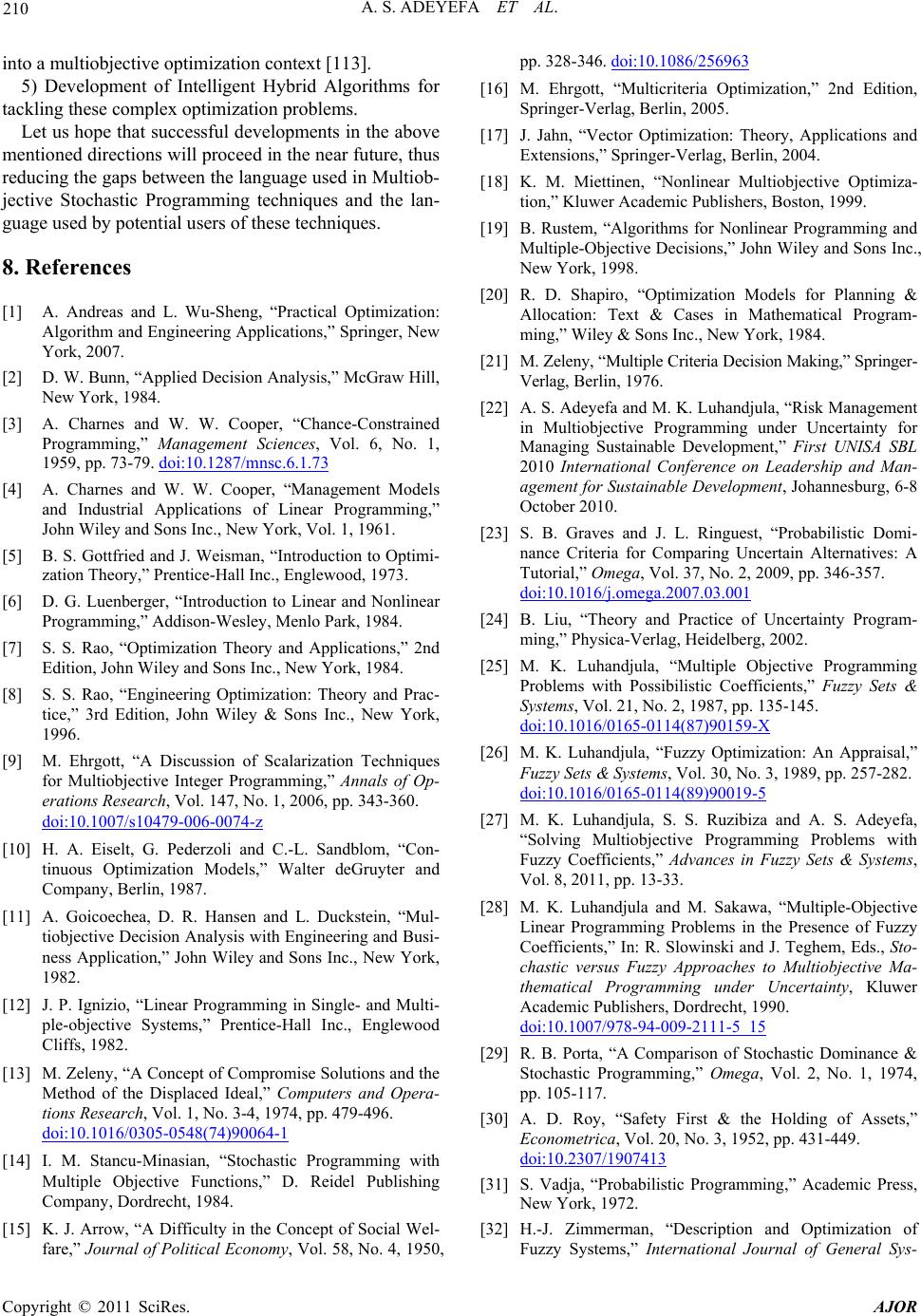 A. S. ADEYEFA ET AL. 210 pment of Intelligent Hybrid Algorithms for ta sful developments in the above m en the language used in Multiob- je 8. [1] er, New raw Hill, into a multiobjective optimization context [113]. 5) Develo ckling these complex optimization problems. Let us hope that succes entioned directions will proceed in the near future, thus reducing the gaps betwe ctive Stochastic Programming techniques and the lan- guage used by potential users of these techniques. References A. Andreas and L. Wu-Sheng, “Practical Optimization: Algorithm and Engineering Applications,” Spring York, 2007. [2] D. W. Bunn, “Applied Decision Analysis,” McG New York, 1984. [3] A. Charnes and W. W. Cooper, “Chance-Constrained Programming,” Management Sciences, Vol. 6, No. 1, 1959, pp. 73-79. doi:10.1287/mnsc.6.1.73 [4] A. Charnes and W. W. Cooper, “Management Models and Industrial Applications of Linear Programming,” John Wiley an 5] B. S. Gottfried d Sons Inc., New York, Vol. 1, 1961. and J. Weisman, “Introduction to Optimi- ,” Addison-Wesley, Menlo Park, 1984. y and Sons Inc., New York, 1984. [ zation Theory,” Prentice-Hall Inc., Englewood, 1973. [6] D. G. Luenberger, “Introduction to Linear and Nonlinear Programming [7] S. S. Rao, “Optimization Theory and Applications,” 2nd Edition, John Wile [8] S. S. Rao, “Engineering Optimization: Theory and Prac- tice,” 3rd Edition, John Wiley & Sons Inc., New York, 1996. [9] M. Ehrgott, “A Discussion of Scalarization Techniques for Multiobjective Integer Programming,” Annals of Op- erations Research, Vol. 147, No. 1, 2006, pp. 343-360. doi:10.1007/s10479-006-0074-z [10] H. A. Eiselt, G. Pederzoli and C.-L. Sandblom, “Con- nizio, “Linear Programming in Single- and Multi- Computers and Opera- tinuous Optimization Models,” Walter deGruyter and Company, Berlin, 1987. [11] A. Goicoechea, D. R. Hansen and L. Duckstein, “Mul- tiobjective Decision Analysis with Engineering and Busi- ness Application,” John Wiley and Sons Inc., New York, 1982. [12] J. P. Ig ple-objective Systems,” Prentice-Hall Inc., Englewood Cliffs, 1982. [13] M. Zeleny, “A Concept of Compromise Solutions and th Method of the Displaced Ideal,” e tions Research, Vol. 1, No. 3-4, 1974, pp. 479-496. doi:10.1016/0305-0548(74)90064-1 [14] I. M. Stancu-Minasian, “Stochastic Programming wit f Political Economy, Vol. 58, No. 4, 1950, h Multiple Objective Functions,” D. Reidel Publishing Company, Dordrecht, 1984. [15] K. J. Arrow, “A Difficulty in the Concept of Social Wel- fare,” Journal o pp. 328-346. doi:10.1086/256963 [16] M. Ehrgott, “Multicriteria Optimization,” 2nd Edition, Springer-Verlag, Berlin, 2005. miza- rk, 1984. certainty for Man- J. L. Ringuest, “Probabilistic Domi- [17] J. Jahn, “Vector Optimization: Theory, Applications and Extensions,” Springer-Verlag, Berlin, 2004. [18] K. M. Miettinen, “Nonlinear Multiobjective Opti tion,” Kluwer Academic Publishers, Boston, 1999. [19] B. Rustem, “Algorithms for Nonlinear Programming and Multiple-Objective Decisions,” John Wiley and Sons Inc., New York, 1998. [20] R. D. Shapiro, “Optimization Models for Planning & Allocation: Text & Cases in Mathematical Program- ming,” Wiley & Sons Inc., New Yo [21] M. Zeleny, “Multiple Criteria Decision Making,” Springer- Verlag, Berlin, 1976. [22] A. S. Adeyefa and M. K. Luhandjula, “Risk Management in Multiobjective Programming under Un Managing Sustainable Development,” First UNISA SBL 2010 International Conference on Leadership and agement for Sustainable Development, Johannesburg, 6-8 October 2010. [23] S. B. Graves and nance Criteria for Comparing Uncertain Alternatives: A Tutorial,” Omega, Vol. 37, No. 2, 2009, pp. 346-357. doi:10.1016/j.omega.2007.03.001 [24] B. Liu, “Theory and Practice of Uncertainty Program- ming,” Physica-Verlag, Heidelberg, 2002. [25] M. K. Luhandjula, “Multiple Objective Programming Problems with Possibilistic Coefficients,” Fuzzy Sets & Systems, Vol. 21, No. 2, 1987, pp. 135-145. doi:10.1016/0165-0114(87)90159-X [26] M. K. Luhandjula, “Fuzzy Optimization: An Appraisal,” Fuzzy Sets & Systems, Vol. 30, No. 3, 1989, pp. 257-282. doi:10.1016/0165-0114(89)90019-5 [27] M. K. Luhandjula, S. S. Ruzibiza and A. S. Adeyefa, “Solving Multiobjective Programming Problems w Fuzzy Coefficients,” Advances in Fuzith zy Sets & Systems, iple-Objective bjective Ma- ncertainty, Kluwer Vol. 8, 2011, pp. 13-33. [28] M. K. Luhandjula and M. Sakawa, “Mult Linear Programming Problems in the Presence of Fuzzy Coefficients,” In: R. Slowinski and J. Teghem, Eds., Sto- chastic versus Fuzzy Approaches to Multio thematical Programming under U Academic Publishers, Dordrecht, 1990. doi:10.1007/978-94-009-2111-5_15 [29] R. B. Porta, “A Comparison of Stochastic Dominance & Stochastic Programming,” Omega, Vol. 2, No. 1, 1974, pp. 105-117. [30] A. D. Roy, “Safety First & the Holding of Assets,” Econometrica, Vol. 20, No. 3, 1952, pp. 431-449. doi:10.2307/1907413 [31] S. Vadja, “Probabilistic Programming,” Academic Press, New York, 1972. [32] H.-J. Zimmerman, “Description and Optimization of Fuzzy Systems,” International Journal of General Sys- Copyright © 2011 SciRes. AJOR  211 A. S. ADEYEFA ET AL. tems, Vol. 2, No. 4, 1976, pp. 209-215. doi:10.1080/03081077608547470 [33] H. Simon, “A Behavioral Model of Rational Choice in Models of Man, Social and Rational,” Macmillan, New York, 1957. [34] A. S. Adeyefa, “Methodological Approaches for Mul- tiobjective Stochastic Linear Programmimg Prob IFORS Conference, Sa lems,” ndton, 13-19 July 2008. ent Science, Vol. 21, No. 4, 1974, pp. [35] H. Levy and J. Paroush, “Multiperiod Stochastic Domi- nance,” Managem 428-435. doi:10.1287/mnsc.21.4.428 [36] M. K. Luhandjula, A. S. Adeyefa and S. Mukeru, “Satis- ficing Solutions for Multiobjective Stoc gramming Problems,” Submitted, 2 hastic Linear Pro- 011. nd under Chance and Imprecise Constraints,” [37] D. Panda, S. Kar, K. Maity and M. Maiti, “A Single Pe- riod Inventory Model with Imperfect Production and Sto- chastic Dema European Journal of Operational Research, Vol. 188, No. 1, 2008, pp. 121-139. doi:10.1016/j.ejor.2007.04.009 [38] S. Hulsurkar, M. P. Biswal and S. B. Sinha, “Fuzzy Pro- gramming Approach to Multi-Objective Stochastic Linear Programming Problem,” Fuzzy Sets and Systems, Vol. 88, No. 2, 1997, pp. 173-181. doi:10.1016/S0165-0114(96)00056-5 [39] S. B. Sinha, S. Hulsurkar and M. P. Biswal, “Fuzzy Pro- gramming Approach to Multi-Objective Stochastic Pro- gramming Problems When Bi’s Follow Joint Normal Dis- tribution,” Fuzzy Sets and Systems, Vol. 109, No. 1, 2000, pp. 91-96. doi:10.1016/S0165-0114(98)00070-0 [40] M. Abbasi and M. Houshmand, “Production Planning and Performance Optimization of Reconfigurable Manufac- turing Systems Using Genetic Algorithm,” International Journal of Advanced Manufacturing Technology, Vol. 54, No. 14, 2010, pp.373-392. [41] X. R. Gandibleux, M. Seva “Metaheuristics for Multiobjective Op ux, K. Sörensen and V. Tkindt, timization,” Sprin- Strauss, ger-Verlag, Berlin, 2004. [42] T. Ibaraki, K. Nonobe and M. Yagiura, “Metaheuristics: Progress as Real Problem Solvers,” Springer, New York, 2005. [43] K. F. Doerner, W. J. Gutjahr, R. F. Hartle and C. “Nature-Inspired Metaheuristics for Multiobjective Ac- tivity Crashing,” Omega, Vol. 36, No. 6, 2008, pp. 1019- 1037. doi:10.1016/j.omega.2006.05.001 [44] J. Dréo, A. Pétrowski, P. Siarry and E. Taillard, “Meta- heuristics for Hard Optimization,” Springer-Verlag, Ber- Re-Entrant Hybrid Flow Shop 1016/j.ejor.2009.06.031 lin, 2006. [45] F. Dugardin, F. Yalaoui and L. Amodeo, “New Multi- objective Method to Solve Scheduling Problem,” European Journal of Operational Research, Vol. 203, No. 1, 2010, pp. 22-31. doi:10. ence, Vol. 3410, Multi-Objective 0-1 Programming Based [46] X. R. Gandibleux and M. Ehrgott, “(1984-2004)-20 Years of Multiobjective Metaheuristics, But What About the Solution of Combinatorial Problems with Multiple Ob- jectives?” Lecture Notes in Computer Sci 2005, pp. 33-46. [47] H. Katagiri, M. Sakawa, K. Kato and I. Nishizaki, “A Fuzzy Random on the Expectation Optimization Model Using Possibility and Necessity Measures,” Mathematical and Computer Modelling, Vol. 40, No. 3-4, 2004, pp. 530-539. doi:10.1016/j.mcm.2003.08.007 [48] J. Dupačová, “Applications of Stochastic Programming: Achievements and Questions,” European Journal of Op- erational Research, Vol. 140, No. 2, 2002, pp. 281-290. doi:10.1016/S0377-2217(02)00070-X [49] J. Mayer, “Stochastic Linear Programming Algorithms,” Overseas Publishers Association, 1984. [50] R. Slowinski and J. Teghem, “Stochastic versus Fuzzy Approaches to Multiobjective Mathematical Program- ming under Uncertainty,” Kluwer Academic Publishers, Dordrecht, 1990. doi:10.1007/978-94-009-2111-5 [51] I. I. Croley, E. R. Thomas and N. R. Kuchibhotl tiobjective Risks in Reservoir a, “Mul- Operation,” Water Re- sources Research, Vol. 15, No. 4, 1979, pp. 807-814. doi:10.1029/WR015i004p00807 [52] A. Goicoechea, L. Duckstein and M. Fogel, “Multiple Objectives under Uncertainty: An Illus trative Application 002p00203 of Protrude,” Water Resources Research, Vol. 15, No. 2, 1979, pp. 203-210. doi:10.1029/WR015i royes, : A Renewable & Sustain- [53] H. Fazlollahtabar and I. Mahdavi, “Applying Stochastic Programming for Optimizing Production Time & Cost in an Automated Manufacturing System,” International Con- ference on Computers & Industrial Engineering, T 6-9 July 2009, pp. 1226-1230. [54] A. Alarcon-Rodriguez, G. Ault and S. Galloway, “Multi- objective Planning of Distributed Energy Resources Review of the State-of-the-Art,” able Energy Reviews, Vol. 14, No. 5, 2010, pp. 1353-1366. doi:10.1016/j.rser.2010.01.006 [55] M. Bravo and I. Gonzalez, “Applying Stochastic Goal Programming: A Case Study on Water Use Planning,” European Journal of Operational Research, Vol. 196, No. 39, 2009, pp. 1123-112. doi:10.1016/j.ejor.2008.04.034 [56] T. Z. Caner and Ü. A. Tamer, “Tactical Level Planning in Float Glass Manufacturing with Co-Production, Random Yields & Substitutable Products,” European Journal of In: R. Slow- Operational Research, Vol. 199, No. 1, 2009, pp. 252- 261. [57] J. Teghem, “Strange an Interactive Method for Multiob- jective Stochastic Linear Programming and Strange- Momix Its Extension to Integer Variables,” inski and J. Teghem, Eds., Stochastic versus Fuzzy Ap- proaches to Multiobjective Mathematical Programming under Uncertainty, Kluwer Academic, Dordrecht, 1990. doi:10.1007/978-94-009-2111-5_6 [58] J. Teghem, D. Dufrane, M. Thauvoye and P. L. Kunsch, “Strange: An Interactive Method for Multi-Objective Linear Programming under Uncertainty,” European Jour- nal of Operational Research, Vol. 26, No. 1, 1986, pp. 65-82. doi:10.1016/0377-2217(86)90160-8 [59] J. Teghem and P. Kunsch, “Application of Multiobjective Copyright © 2011 SciRes. AJOR 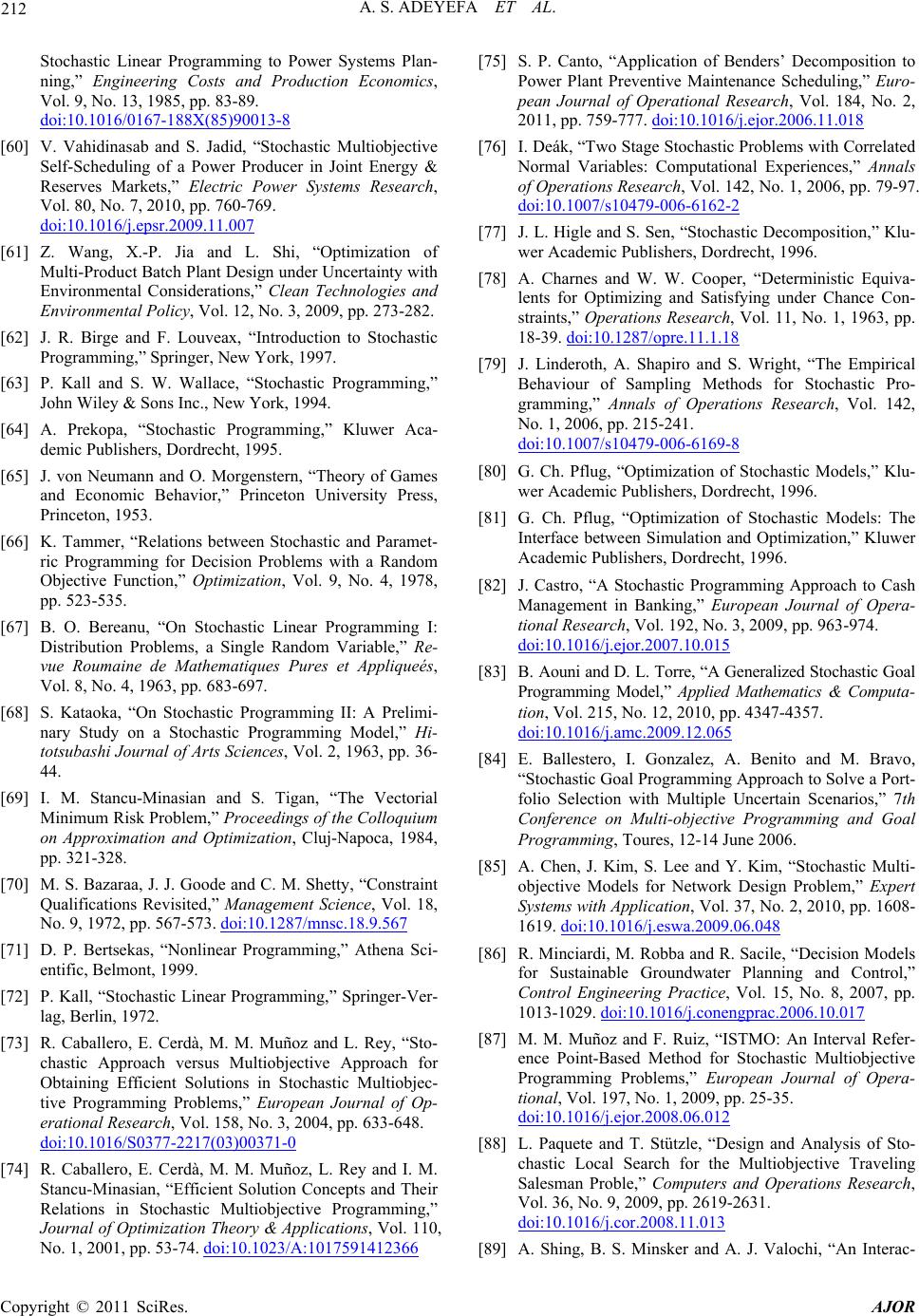 A. S. ADEYEFA ET AL. 212 Stochastic Linear Programming to Power Systems Plan- ning,” Engineering Costs and Production Economics, Vol. 9, No. 13, 1985, pp. 83-89. doi:10.1016/0167-188X(85)90013-8 [60] V. Vahidinasab and S. Jadid, “Stochastic Multiobjective Self-Scheduling of a Power Producer in Joint Energy & Reserves Markets,” Electric Powe r Systems Research, Vol. 80, No. 7, 2010, pp. 760-769. doi:10.1016/j.epsr.2009.11.007 [61] Z. Wang, X.-P. Jia and L. Shi, “Optimization of Multi-Product Batch Plant Design under Uncertainty with Environmental Considerations,” Clean Technologies and stic Programming,” rn, “Theory of Games ceton University Press, gramming I: ming II: A Prelimi- Environmental Policy, Vol. 12, No. 3, 2009, pp. 273-282. [62] J. R. Birge and F. Louveax, “Introduction to Stochastic Programming,” Springer, New York, 1997. [63] P. Kall and S. W. Wallace, “Stocha John Wiley & Sons Inc., New York, 1994. [64] A. Prekopa, “Stochastic Programming,” Kluwer Aca- demic Publishers, Dordrecht, 1995. [65] J. von Neumann and O. Morgenste and Economic Behavior,” Prin Princeton, 1953. [66] K. Tammer, “Relations between Stochastic and Paramet- ric Programming for Decision Problems with a Random Objective Function,” Optimization, Vol. 9, No. 4, 1978, pp. 523-535. [67] B. O. Bereanu, “On Stochastic Linear Pro Distribution Problems, a Single Random Variable,” Re- vue Roumaine de Mathematiques Pures et Appliqueés, Vol. 8, No. 4, 1963, pp. 683-697. [68] S. Kataoka, “On Stochastic Program nary Study on a Stochastic Programming Model,” Hi- totsubashi Journal of Arts Sciences, Vol. 2, 1963, pp. 36- 44. [69] I. M. Stancu-Minasian and S. Tigan, “The Vectorial Minimum Risk Problem,” Proceedings of the Colloquium on Approximation and Optimization, Cluj-Napoca, 1984, pp. 321-328. [70] M. S. Bazaraa, J. J. Goode and C. M. Shetty, “Constraint Qualifications Revisited,” Management Science, Vol. 18, No. 9, 1972, pp. 567-573. doi:10.1287/mnsc.18.9.567 [71] D. P. Bertsekas, “Nonlinear Programming,” Athena Sci- aballero, E. Cerdà, M. M. Muñoz and L. Rey, arch, Vol. 158, No. 3, 2004, pp. 633-648. entific, Belmont, 1999. [72] P. Kall, “Stochastic Linear Programming,” Springer-Ver- lag, Berlin, 1972. [73] R. C “Sto- chastic Approach versus Multiobjective Approach for Obtaining Efficient Solutions in Stochastic Multiobjec- tive Programming Problems,” European Journal of Op- erational Rese doi:10.1016/S0377-2217(03)00371-0 [74] R. Caballero, E. Cerdà, M. M. Muñoz, L. Rey and I. M. Stancu-Minasian, “Efficient Solution Concepts and Their 23/A:1017591412366 Relations in Stochastic Multiobjective Programming,” Journal of Optimization Theory & Applications, Vol. 110, No. 1, 2001, pp. 53-74. doi:10.10 e Maintenance Scheduling,” Euro- [75] S. P. Canto, “Application of Benders’ Decomposition to Power Plant Preventiv pean Journal of Operational Research, Vol. 184, No. 2, 2011, pp. 759-777. doi:10.1016/j.ejor.2006.11.018 [76] I. Deák, “Two Stage Stochastic Problems with Correlated Normal Variables: Computational Experiences,” Annals of Operations Research, Vol. 142, No. 1, 2006, pp. 79-97. doi:10.1007/s10479-006-6162-2 [77] J. L. Higle and S. Sen, “Stochastic Decomposition,” Klu- wer Academic Publishers, Dordrecht, 1996. [78] A. Charnes and W. W. Cooper, “Deterministic Equiva- lents for Optimizing and Satisfying under Chance Con- straints,” Operations Research, Vol. 11, No. 1, 1963, pp. 18-39. doi:10.1287/opre.11.1.18 [79] J. Linderoth, A. Shapiro and S. Wright, “The Empirical Behaviour of Sampling Methods for Stochastic Pro- gramming,” Annals of Operations Research, Vol. 142, No. 1, 2006, pp. 215-241. doi:10.1007/s10479-006-6169-8 [80] G. Ch. Pflug, “Optimization of Stochastic Models,” Klu- wer Academic Publishers, Dordrecht, 1996. ion,” Kluwer 2009, pp. 963-974. [81] G. Ch. Pflug, “Optimization of Stochastic Models: The Interface between Simulation and Optimizat Academic Publishers, Dordrecht, 1996. [82] J. Castro, “A Stochastic Programming Approach to Cash Management in Banking,” European Journal of Opera- tional Research, Vol. 192, No. 3, doi:10.1016/j.ejor.2007.10.015 [83] B. Aouni and D. L. Torre, “A Generalized Stochastic Goal Programming Model,” Applied Mathematics & Computa- tion, Vol. 215, No. 12, 2010, pp. 4347-4357. doi:10.1016/j.amc.2009.12.065 [84] E. Ballestero, I. Gonzalez, A. Benito and M. Bravo, “Stochastic Goal Programming Approach to Solve a Port- 08- 6.048 folio Selection with Multiple Uncertain Scenarios,” 7th Conference on Multi-objective Programming and Goal Programming, Toures, 12-14 June 2006. [85] A. Chen, J. Kim, S. Lee and Y. Kim, “Stochastic Multi- objective Models for Network Design Problem,” Expert Systems with Application, Vol. 37, No. 2, 2010, pp. 16 1619. doi:10.1016/j.eswa.2009.0 8, 2007, pp. .10.017 [86] R. Minciardi, M. Robba and R. Sacile, “Decision Models for Sustainable Groundwater Planning and Control,” Control Engineering Practice, Vol. 15, No. 1013-1029. doi:10.1016/j.conengprac.2006 [87] M. M. Muñoz and F. Ruiz, “ISTMO: An Interval Refer- ence Point-Based Method for Stochastic Multiobjective Programming Problems,” European Journal of Opera- tional, Vol. 197, No. 1, 2009, pp. 25-35. doi:10.1016/j.ejor.2008.06.012 [88] L. Paquete and T. Stützle, “Design and Analysis of Sto- chastic Local Search for the Multiobjective Traveling Salesman Proble,” Computers and Operations Research, Vol. 36, No. 9, 2009, pp. 2619-2631. doi:10.1016/j.cor.2008.11.013 [89] A. Shing, B. S. Minsker and A. J. Valochi, “An Interac- Copyright © 2011 SciRes. AJOR 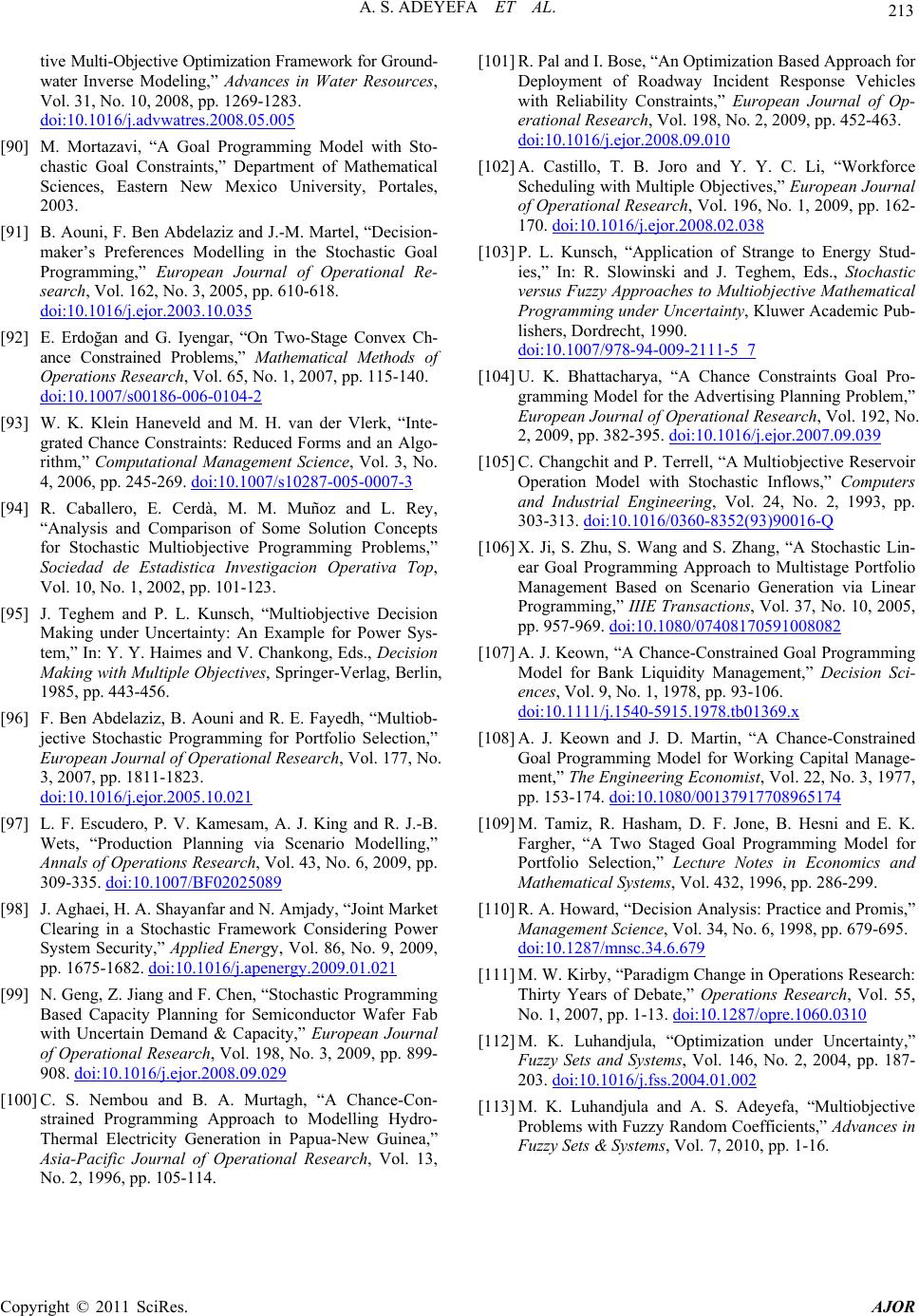 A. S. ADEYEFA ET AL. Copyright © 2011 SciRes. AJOR 213 urces, tive Multi-Objective Optimization Framework for Ground- water Inverse Modeling,” Advances in Water Reso Vol. 31, No. 10, 2008, pp. 1269-1283. doi:10.1016/j.advwatres.2008.05.005 [90] M. Mortazavi, “A Goal Programming Model with Sto- chastic Goal Constraints,” Department o Sciences, Eastern New Mexi f Mathem co University, Portales, f Operationa p. 610-618. atical 2003. [91] B. Aouni, F. Ben Abdelaziz and J.-M. Martel, “Decision- maker’s Preferences Modelling in the Stochastic Goal Programming,” European Journal o search, Vol. 162, No. 3, 2005, p l Re- doi:10.1016/j.ejor.2003.10.035 [92] E. Erdoğan and G. Iyengar, “On Two-Stage Convex Ch- ance Constrained Problems,” Mathematical Methods of Operations Research, Vol. 65, No. 1, 2007, pp. 115-140. doi:10.1007/s00186-006-0104-2 [93] W. K. Klein Haneveld and M. H. van der Vlerk, “Inte- grated Chance Constraints: Reduced Forms and an Algo- rithm,” Computational Management Science, Vol. 3, No. 4, 2006, pp. 245-269. doi:10.1007/s10287-005-0007-3 erativa Top, 3. lag, B [94] R. Caballero, E. Cerdà, M. M. Muñoz and L. Rey, “Analysis and Comparison of Some Solution Concepts for Stochastic Multiobjective Programming Problems,” Sociedad de Estadistica Investigacion Op Vol. 10, No. 1, 2002, pp. 101-12 [95] J. Teghem and P. L. Kunsch, “Multiobjective Decision Making under Uncertainty: An Example for Power Sys- tem,” In: Y. Y. Haimes and V. Chankong, Eds., Decision Making with Multiple Objectives, Springer-Ver erlin, 1985, pp. 443-456. [96] F. Ben Abdelaziz, B. Aouni and R. E. Fayedh, “Multiob- jective Stochastic Programming for Portfolio Selection,” European Journal of Operational Research, Vol. 177, No. 3, 2007, pp. 1811-1823. doi:10.1016/j.ejor.2005.10.021 [97] L. F. Escudero, P. V. Kamesam, A. J. King and R. J.-B. Wets, “Production Planning via Scenario Modelling,” Annals of Operations Research, Vol. 43, No. 6, 2009, pp. 309-335. doi:10.1007/BF02025089 [98] J. Aghaei, H. A. Shayanfar and N. Amjady, “Joint Market Clearing in a Stochastic Framework Considering Power System Security,” Applied Energy, Vol. 86, No. 9, 2009, pp. 1675-1682. doi:10.1016/j.apenergy.2009.01.021 98, No. 3, 2009, pp. 899- 029 [99] N. Geng, Z. Jiang and F. Chen, “Stochastic Programming Based Capacity Planning for Semiconductor Wafer Fab with Uncertain Demand & Capacity,” European Journal of Operational Research, Vol. 1 908. doi:10.1016/j.ejor.2008.09. l Research, Vol. 13, [100] C. S. Nembou and B. A. Murtagh, “A Chance-Con- strained Programming Approach to Modelling Hydro- Thermal Electricity Generation in Papua-New Guinea,” Asia-Pacific Journal of Operationa No. 2, 1996, pp. 105-114. [101] R. Pal and I. Bose, “An Optimization Based Approach for Deployment of Roadway Incident Response Vehicles with Reliability Constraints,” European Journal of Op- erational Research, Vol. 198, No. 2, 2009, pp. 452-463. doi:10.1016/j.ejor.2008.09.010 [102] A. Castillo, T. B. Joro and Y. Y. C. Li, “Workforce Scheduling with Multiple Objectives,” European Journal of Operational Research, Vol. 196, No. 1, 2009, pp. 162- 170. doi:10.1016/j.ejor.2008.02.038 [103] P. L. Kunsch, “Application of Strange to Energy Stud- _7 ies,” In: R. Slowinski and J. Teghem, Eds., Stochastic versus Fuzzy Approaches to Multiobjective Mathematical Programming under Uncertainty, Kluwer Academic Pub- lishers, Dordrecht, 1990. doi:10.1007/978-94-009-2111-5 jor.2007.09.039 [104] U. K. Bhattacharya, “A Chance Constraints Goal Pro- gramming Model for the Advertising Planning Problem,” European Journal of Operational Research, Vol. 192, No. 2, 2009, pp. 382-395. doi:10.1016/j.e [105] C. Changchit and P. Terrell, “A Multiobjective Reservoir Operation Model with Stochastic Inflows,” Computers and Industrial Engineering, Vol. 24, No. 2, 1993, pp. 303-313. doi:10.1016/0360-8352(93)90016-Q [106] X. Ji, S. Zhu, S. Wang and S. Zhang, “A Stochastic Lin- ear Goal Programming Approach to Multistage Portfolio Management Based on Scenario Generation via Linear Programming,” IIIE Transactions, Vol. 37, No. 10, 2005, pp. 957-969. doi:10.1080/07408170591008082 [107] A. J. Keown, “A Chance-Constrained Goal Programming Model for Bank Liquidity Management,” Decision Sci- ences, Vol. 9, No. 1, 1978, pp. 93-106. doi:10.1111/j.1540-5915.1978.tb01369.x [108] A. J. Keown and J. D. Martin, “A Chance-Constrained Goal Programming Model for Working Capital Manage- ment,” The Engineering Economist, Vol. 22, No. 3, 1977, pp. 153-174. doi:10.1080/00137917708965174 [109] M. Tamiz, R. Hasham, D. F. Jone, B. Hesni and E. K. Fargher, “A Two Staged Goal Programming Model for e and Promis,” , pp. 679-695. Portfolio Selection,” Lecture Notes in Economics and Mathematical Systems, Vol. 432, 1996, pp. 286-299. [110] R. A. Howard, “Decision Analysis: Practic Management Science, Vol. 34, No. 6, 1998 doi:10.1287/mnsc.34.6.679 [111] M. W. Kirby, “Paradigm Change in Operations Research: Thirty Years of Debate,” Operations Research, Vol. 55, No. 1, 2007, pp. 1-13. doi:10.1287/opre.1060.0310 [112] M. K. Luhandjula, “Optimization under Uncertainty,” Fuzzy Sets and Systems, Vol. 146, No. 2, 2004, pp. 187- 203. doi:10.1016/j.fss.2004.01.002 [113] M. K. Luhandjula and A. S. Adeyefa, “Multiobjective Problems with Fuzzy Random Coefficients,” Advances in Fuzzy Sets & Systems, Vol. 7, 2010, pp. 1-16.
|